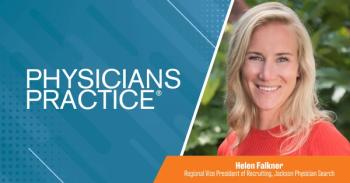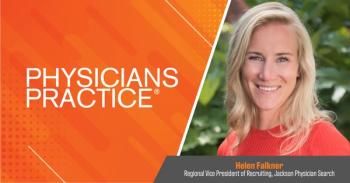
Different Solutions for the Physician Shortage
There is a shortfall of physicians in the field - here are a few potential ways to keep up with increasing demand.
Even as physicians are busier than ever, some with exceedingly heavy panels, the Association of American Medical Colleges (AAMC) has alarmingly
Jason Farr, a Texas-based recruiter with The Medicus Firm, a national physician recruiting firm, remembers hearing about a physician shortage coming over a decade ago, centered around primary care and rural areas. "Fast-forward here we are a decade later and it is as real as can be," he says.
There are a number of reasons for this shortage, ranging from baby boomer aged physicians facing retirement, as well as an influx of patients aging and needing more medical care. Millennial physicians are more concerned about the
Resources for Residents
One answer to this physician shortfall might appear to be solved by an increase in medical school enrollment. However, training programs for residents and fellows haven't expanded at the same rate, creating a bottleneck in the residency pipeline. According to an
Indeed, in 2017, there were a record-breaking 35,969 U.S. and international medical school students and graduates competing for only 31,757 positions, according to the
"We have a shortage of physicians but a surplus of talent," Farr says.
Funding for residents is expensive, as well, and most hospitals and medical groups do not have extra funds to pay for them or they go way over budget in order to do so. In 1997, Congress capped the amount of funds for Medicare support for graduate medical education (GME) "at how many residents you were training at the end of 1996," says Len Marquez, Senior Director of Government Relations and Legislative Advocacy at AAMC. This has contributed to the slowdown in the number of medical residents who can enter the workforce. "If Medicare funding isn't expanded to include more GME positions, then there is no other viable source," Jacobs says.
The AAMC is sponsoring legislation that seeks to raise these caps. Two bipartisan bills have been introduced in
While the bills are no quick fix since "it's difficult to move legislation right now that costs the federal government money," Marquez says, he's hopeful about the bipartisan support they're gaining and are continuing to educate. "Because it's not like in 2030 Congress can say we need additional physicians and just flip the switch."
Some institutions are creating their own medical-school-to-residency pathways, such as Kaiser Permanente, an Oakland, Calif.-based managed care company, which currently trains 600 residents annually and
Senior Program Integration Manager for the newly forming Kaiser Permanente School of Medicine, Aldina Washington, MBA, says by email, "We are currently in the very preliminary stages of developing the school, starting with establishing an organizational structure and beginning the accreditation process."
Farr says it's the beginning of a process that he expects will grow as hospital systems and medical groups become desperate to fill physician gaps. "They're just going to start saying 'we're going to train ourselves,'" he says.
Attract Residents to Underserved Areas
For medical school graduates who are ready to go but lack a residency spot, Arkansas, Kansas, Missouri and Utah have passed legislation to provide provisional licenses to some of these medical school graduates who have not been able to find a residency spot. However, there’s a condition. "With these provisional licenses they can practice primary care under the medical license of another physician, but it has to be in a medically underserved area," Farr explains. He calls this "one of the most creative solutions that I've heard. It's addressing an untapped pool of candidates."
Midwestern states may also start to fall in line with this approach, says Dave Lenihan, PhD, JD, President of Ponce Health Science University in Puerto Rico, and President and CEO of Tiber Health, a medical education company developing new curriculum and analytics strategies. However, he feels that adding incentive for newly graduated physicians to take residencies in underserved parts of the country requires reducing the cost of medical education.
"If we want to put new physicians in rural America, we can't have students with a quarter million dollars in debt," Lenihan says.
One solution he proposes is to change the way medical education is delivered, thus reducing its cost, as they do at Tiber.
The cost of a new medical school can range between $150 to over $600 million in development costs. This includes building and curriculum design. When a new campus is opened, a significant amount of money goes towards curriculum development, he explains. “Tiber uses a standardized curriculum so that the costs of development are minimal. The cost of the faculty is spread across many more students. Because the curriculum is already developed with world-class faculty and approved to a Gold Standard, the proposed new school can open in a significantly reduced period of time.”
At Ponce they also offer a "flipped classroom" approach - in which students listen to their lectures offline, out of the classroom, and use class time to go over clinical cases. "You don't need all that brick and mortar -that's not what's required to train these future doctors."
Embracing Physician Extenders
One of the quicker solutions to get more patients served may be to train more physician assistants (PAs). There are already nearly
Physician extenders "can help one physician care for more than one patient at a time," says Karen Sibert, MD, President of the California Society of Anesthesiologists and a professor at UCLA. In her field, physician anesthesiologists rely on the support of advanced practice practitioners and assistants - either certified registered nurse anesthetists (CRNA) or certified anesthesiologist assistants (CAA). "They are exactly analogous to what PAs are for a primary doctor or surgeon," she explains. They are trained in a medical, not nursing, model, and work directly under the supervision of physician anesthesiologists. The CAAs, she says, "provide an opportunity for the physician anesthesiologist to focus on emergencies and saving lives, and not some of the lower level tasks such as initial screening and paperwork."
This speaks to many physician frustrations with doing work that doesn't make the best use of their talents. "There are days where, here I am with a lot of experience and higher education, and I'm pushing a stretcher down the hall for lack of somebody else to do it," Sibert says. She does not consider herself above the work, but says "it's really not an effective use of society's resources."
Technology
While physicians have mixed feelings about technology - and much frustration with the increased burdens of their EHRs - technology is expanding, and may be able to alleviate some of the burdens of the physician shortage. Particularly in the arena of telehealth, where physicians can schedule virtual visits with patients where the patient doesn't have to come into the office.
"If you're talking about a family medicine physician being able to manage a panel of 5000 patients who can then, with some technology, ramp up to 7500 patients, that's huge," Farr says.
Jeff Barson, a Utah-based healthcare consultant in virtual care, medical education, and artificial intelligence, goes so far as to suggest that technology is the only way to meet patient demand. "There is no capability to solve the problems coming around the scalability of delivery of care with human labor," he says. Trying to add more physicians, he feels, is a losing battle. "The reason it's not possible, is it's not working now. The United States has the best delivery of healthcare available and still it is far short of where the actual need is."
He believes that artificial intelligence (AI) algorithms will shift the roles of physicians from a "knowledge-based role into more of a skills role." There will be less reason to memorize information in the same way anymore because all of that information will be available in an AI-driven database that can not only bring up the information at a moment's notice, but help in diagnosis. Skills around the decision-making process will still be needed," he says, but it could make it possible for fewer physicians to do more work with less effort.
Creative Retirement Solutions
Farr points out that many institutions could encourage physicians to push off retirement by modifying their hours. "Rather than allowing them to go from full-time to zero and leave a hole, think about a creative way to keep retiring physicians on staff." If two physicians go to half time instead of leaving, "you can cut your loss by fifty percent," says Farr.
Medical groups and hospitals will most likely have to rely upon a combination of solutions. Whatever methods they choose, Lenihan concludes, "We have to fix this now otherwise we'll be in a giant mess in ten years."
Newsletter
Optimize your practice with the Physicians Practice newsletter, offering management pearls, leadership tips, and business strategies tailored for practice administrators and physicians of any specialty.








